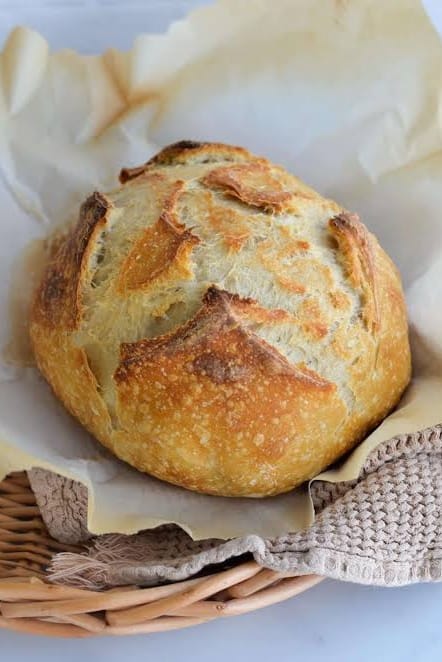Sourdough bread has been around for thousands of years, dating back to ancient Egypt. It was one of the earliest forms of leavened bread, relying on wild yeast and bacteria instead of commercial yeast.

Why Sourdough Bread Is Special
Unlike regular bread, sourdough has a distinct tangy flavor, chewy texture, and crisp crust. It’s also easier to digest because the fermentation process breaks down gluten and phytic acid, making nutrients more accessible.

Why This Recipe Is Unique
This recipe is straightforward yet produces bakery-quality sourdough. With just a few ingredients and patience, anyone can master the art of sourdough baking at home.

Ingredients You’ll Need
Flour – 4 cups (500g) bread flour or all-purpose flour
Water – 1 ¾ cups (415ml), lukewarm
Sourdough Starter – ½ cup (100g), active and bubbly
Salt – 2 teaspoons
How to Prepare Sourdough Bread
Mix the Dough – In a large mixing bowl, combine the flour, water, and sourdough starter. Stir until well incorporated
Rest and Autolyse – Cover the bowl and let the dough rest for 30 minutes to allow the flour to absorb water.
Add Salt – Sprinkle the salt over the dough and knead it in until fully absorbed.
Stretch and Fold – Over the next 3-4 hours, stretch and fold the dough every 30 minutes to develop gluten structure.
Bulk Fermentation – Cover the bowl and let the dough rise at room temperature for 6-8 hours, or until it doubles in size.
Shaping the Dough – Gently shape the dough into a round or oval loaf.
Second Rise – Place the shaped dough in a floured proofing basket and let it rise for another 2-4 hours.
Cool and Enjoy – Let the sourdough cool completely before slicing to allow the crumb to set properly.

Why is my sourdough bread too dense?
A dense loaf can result from an underdeveloped starter, insufficient fermentation, or not enough stretch and folds. Ensure your starter is active and allow enough rising time.
How do I know when my sourdough is fully proofed?
Perform the "poke test"—gently press the dough with your finger. If it slowly springs back but leaves a slight indentation, it’s ready to bake.
What’s the best way to store my sourdough starter?
If baking frequently, store it at room temperature and feed daily. For occasional baking, keep it in the fridge and feed once a week.
Tips for Perfect Sourdough Bread
Use an Active Starter – A strong and bubbly sourdough starter ensures a good rise and complex flavor.
Measure Flour Correctly – Weigh the flour for accuracy, or spoon it into a measuring cup and level it off.
Do Not Over-Knead – Stretch and fold the dough instead of traditional kneading to build gluten without overworking it.
Allow Proper Fermentation – Long fermentation at room temperature develops flavor and texture.
Bake at the Right Temperature – Preheat the oven to 450°F (230°C) and use steam for a crisp crust.

Storage Options
Room Temperature: Store sourdough in a paper bag or bread box for up to 3 days.
Refrigeration: To keep it fresh longer, store in an airtight container in the fridge for up to a week.
Freezing: Slice the bread and freeze in a sealed bag for up to 3 months. Toast or warm before serving.
Happy baking!
Join Our Nest! Get Exclusive Tips and Freebies
Unlock a world of creativity, inspiration, and practical advice with LadiesNest.
Join Our Nest! Get Exclusive Tips and Freebies
Categories
Solutions
Discover budget meal plans and delicious dessert recipes to eat well while saving time and money effortlessly.
Learn how to start and grow a successful small business.





